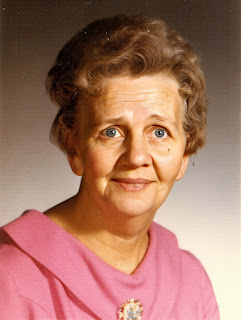I have a new article, co-authored with Karin Helmstaedt, published this week in Family Tree (UK) magazine titled Witch Hunts during the Little Ice Age. The piece summarizes the persecution of individuals for witch craft, events that escalated during that cool period due to challenging living conditions.
We have compiled a long list of references about the subject including articles, books, websites and videos but did not have the space in the magazine to include them. They are shown below and include not only the ones quoted in the article but many others we think readers may be interested in.
We hope you will be able to obtain a copy of the article and enjoy reading about the events. For subscription information contact the publisher at www.family-tree.co.uk
Witch Hunts and the Little Ice Age
Selected References & Further Reading
Baker, Emerson W. (2015). A Storm of Witchcraft: The
Salem Trials and the American Experience. Oxford University Press. 398 pp.
Behringer, Wolfgang. (1995). Weather, Hunger and Fear:
Origins of the European Witch-Hunts in Climate, Society and Mentality. German
History, 13(1), pp. 1-27. https://www.uni-saarland.de/fileadmin/upload/lehrstuhl/behringer/PDF/weather.pdf
Behringer, Wolfgang. (1999). Climatic Change and
Witch-Hunting: The impact of the Little Ice Age on mentalities. Climatic
Change, 43, pp. 335-351. [important article for old treatises references] file:///F:/Downloads/Climatic_Change_and_Witch_Hunting%20(2).pdf
Behringer, Wolfgang. (2004). Witches and Witch-Hunts: A
global history. Wiley, 320 pp.
Behringer, Wolfgang. (2010). A Cultural History of
Climate. (published in German in 2007 as Kulturgeschichte des Klimas
by C. H. Beck; translated by Patrick Camiller). Cambridge: Polity Press. 295
pp.
Boyer, Paul & Stephen
Nissenbaum (Eds.). (1977). The Salem Witchcraft Papers: Verbatim
transcriptions of the court records, in three volumes. De Capo Press. https://salem.lib.virginia.edu/category/swp.html
Briggs, Robin. (2007). The Witches of Lorraine. Oxford University Press, 416 pp.
Clayton, John A. (2007). The Lancashire Witch Conspiracy: A History of Pendle
Forest and the Pendle Witch Trials. Barrowford Press, 302 pp.
Dillinger, Johannes. (2019). The
Routledge History of Witchcraft. Routledge, 422 pp.
Drake, Frederick C. (1968).
Witchcraft in the American Colonies, 1647-62. American Quarterly, 20(4),
pp. 694-725.
Federici, Silvis & Alice Markham-Cantor. (2003). How social turmoil has increased witch hunts throughout history. Scientific American, May issue. https://www.scientificamerican.com/article/how-social-turmoil-has-increased-witch-hunts-throughout-history/
Gent, Frank J. (2017). The
Trial of the Bideford Witches. Independently Published, 78 pp.
Godbeer, Richard. (1993). The
Devil’s Dominion: Magic and Religion in Early New England. Cambridge University
Press, 268 pp. [search on Ancestry.com; browse on Internet Archive https://archive.org/details/devilsdominionma0000godb_p8m2]
Goodare, Julian, Rita Voltmer
& Liv Helene Willumsen (Eds.). (2020). Demonology and Witch-Hunting in
Early Modern Europe. Routledge, 402 pp.
Helmstaedt, Karin. (2023).
Remembering my ancestor who was burned as a witch. Deutsche Welle, Culture /
Germany, 30 April 2023. https://www.dw.com/en/a-witch-in-the-family/a-65447802
Hudson, Chris. (2016). Witch
Trials: Discontent in Early Modern Europe. Working Paper No. HEIDWP11-2016,
Graduate Institute of International and Development Studies, International
Economics Department, Working Paper Series. https://www.econstor.eu/bitstream/10419/156127/1/871678241.pdf
Kieckhefer, Richard. (1976). European Witch Trials: Their
foundations in popular and learned culture 1300-1500. University of
California Press, 181 pp.
Lamb, Hubert H. (1977). Climate:
Present, Past and Future, Volume 2 – Climatic History and the Future.
Methuen & Co. Ltd., 835 pp.
Leeson, Peter R. & Jacob
W. Russ. (2017). Witch Trials. The Economic Journal, August, pp.
2066-2105. https://www.peterleeson.com/Witch_Trials.pdf
Levack, Brian P. (2013). The
Oxford Handbook of Witchcraft in Early Modern Europe and Colonial America. Oxford
University Press, 644 pp.
Maxwell-Stuart, Peter G.
(2011). Witch Beliefs and Witch Trials in the Middle Ages: Documents and
readings. Continuum International Publishing Group, 228 pp.
Miguel, E. (2005). Poverty and
Witch Killing. The Review of Economic Studies, 72(4), 1153-1172. http://emiguel.econ.berkeley.edu/assets/miguel_research/45/_Paper__Poverty_and_Witch_Killing.pdf
Oster, Emily. (2004).
Witchcraft, Weather and Economic Growth in Renaissance Europe. Journal of
Economic Perspectives, 18(1), pp. 215-228. https://www.sfu.ca/~poitras/jpe_witches_04.pdf
Pfister, Ulrich. (2010).
Consumer Prices and Wages in Germany, 1500-1850. Center for quantitative
Economics. 45 pp. https://www.wiwi.uni-muenster.de/cqe/sites/cqe/files/CQE_Paper/CQE_WP_15_2010.pdf
Potts, Thomas. (1613). The
Wonderfull Discoverie of Witches in the Countie of Lancaster (Reproduced as
Potts’s Discovery of Witches, introduction by James Crossley, 1845. https://archive.org/details/pottsdiscoveryw01pottgoog/page/n9/mode/2up)
Rummel, Walter. (1991). Bauern,
Herren, und Hexen. Kritische Studien zur Geschichtswissenschaft 94,
Vandenhoeck & Ruprecht, 424 pp.
Scott, Susan & Christopher J.
Duncan. (1997). The mortality crisis of 1623 in north-west England. Local Population Studies, 58(Spring),
pp. 14-25. http://www.localpopulationstudies.org.uk/PDF/LPS58/LPS58_1997_14-25.pdf
Shepheard, W. Wayne. (2018). Surviving Mother Nature’s Tests: The effects climate change and other
natural phenomena have had on the lives of our ancestors. Unlock the Past,
179 pp.
Shepheard, Wayne. (2023). Genealogy
and the Little Ice Age. Unlock the Past, 82 pp.
Voltmer, Rita. (2008). Hexen: Wissen was stimmt.
Verlag Herder, 128 pp.
Zarrillo, Dominick. (2018). The Icelandic Witch Craze of the
Seventeenth Century. The College of New Jersey. file:///F:/Downloads/The_Icelandic_Witch_Craze_of_the_Sevente%20(2).pdf
Old Treatises
Kramer, Heinrich
& Jakob Sprenger. (1486). Malleus Maleficarum (Hammer of Witches - English
Translation by Montague Summers) https://ia803003.us.archive.org/13/items/b31349717/b31349717.pdf
Molitor, Ulrich.
(1489). Opusculum de sagis maleficis. (Concerning Witches and
Sorceresses) https://ia601600.us.archive.org/25/items/de-lamiis-et-pythonicis-mulieribus/De%20Lamiis%20et%20Pythonicis%20Mulieribus.pdf
Plantsch, Martin.
(1507). Opusculum de sagis maleficis. [in Latin] (A treatise on
witchcraft) https://books.google.ca/books?id=CqpSAAAAcAAJ&printsec=frontcover&source=gbs_atb&redir_esc=y#v=onepage&q&f=false
Scot, Reginald.
(1584) The Discoverie of Witchcraft https://ia800201.us.archive.org/32/items/discoverieofwitc00scot/discoverieofwitc00scot.pdf
Roberts, Alexander.
(1616). A Treatise of Witchraft. https://archive.org/details/b30333416
Bragge, Francis. (1712). Witchcraft Farther Display’d. https://iiif.wellcomecollection.org/pdf/b30545158
Boulton, Richard. (1722). The Possibility and Reality of
Magick, Sorcery, and Witchcraft, demonstrated, or a Vindication of a
Compleat History of Magick, Sorcery, and Witchcraft. https://archive.org/details/possibilityreali00boul/page/n3/mode/2up
Websites & Online
References
Boston Public Library: Salem
Witch Trials https://guides.bpl.org/salemwitchtrials/home
Cornell University Witchcraft
Collection https://rmc.library.cornell.edu/witchcraftcoll/
Early Modern Witch Trials https://www.nationalarchives.gov.uk/education/resources/early-modern-witch-trials/
Germanna Foundation
newsletter, Spring 2016 https://germanna.org/wp-content/uploads/2014/07/Germanna-Foundation-Newsletter-Spring-2016-web.pdf
Lancashire County Online
Parish Clerk pages https://www.lan-opc.org.uk/
Pendle Witches https://en.wikipedia.org/wiki/Pendle_witches
Wellcome Collection: Names of
the Witches (in Scotland) 1658 [search on Ancestry.com] https://iiif.wellcomecollection.org/pdf/b19111319
Witches and Witchcraft on The
Online Books Page begin: https://onlinebooks.library.upenn.edu/webbin/book/browse?type=subject&index=185238&key=wit%20and%20humor%20african%20american&c=c
Witchcraft Bibliography https://libguides.bodleian.ox.ac.uk/ld.php?content_id=32757238
Witchcraft & the law in
early modern Europe & USA: Home https://libguides.bodleian.ox.ac.uk/law-witch
Witchfinder General Project
(Scotland) http://witches.is.ed.ac.uk/death/
Videos
1612: The Disturbing Witch
Trial That Shook Britain | The Pendle Witch Child | Chronicle https://www.youtube.com/watch?v=eQrva6RAkak
Dark Age Britain’s War with
Witchcraft: A century of murder https://www.youtube.com/watch?v=MBBHfZwjxYY
Death in the Dark Country: the
Pendle Witch Trials https://www.youtube.com/watch?v=Wegs_uHDZiE
Witches – A century of murder https://www.youtube.com/watch?v=Rpic8sIh2JM
The Evil Career of Matthew
Hopkins the Witchfinder General https://www.youtube.com/watch?v=MvVm29b1EP4
Why Witch Hunts are not just a
Dark Chapter from the Past
https://www.youtube.com/watch?v=Y2Q1Vo9kduo






























